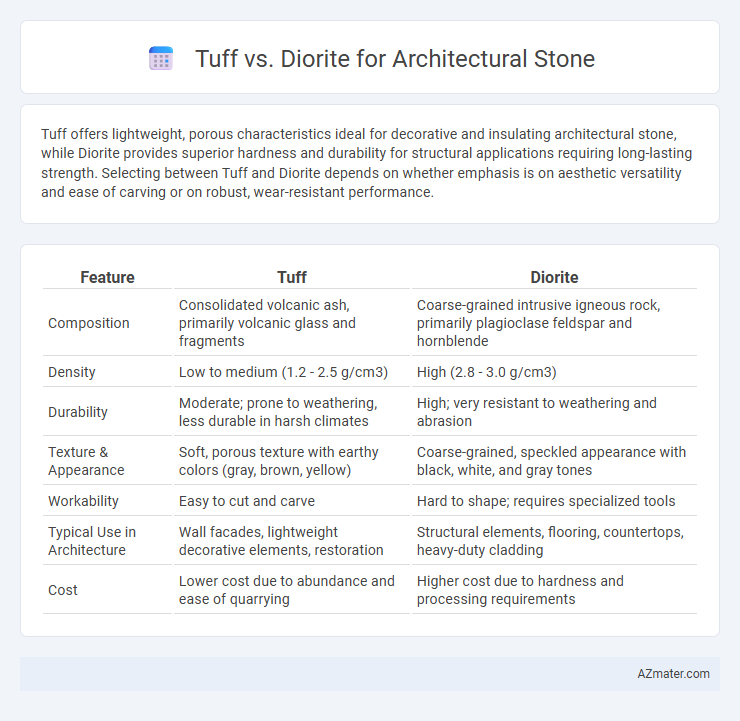Tuff offers lightweight, porous characteristics ideal for decorative and insulating architectural stone, while Diorite provides superior hardness and durability for structural applications requiring long-lasting strength. Selecting between Tuff and Diorite depends on whether emphasis is on aesthetic versatility and ease of carving or on robust, wear-resistant performance.
Table of Comparison
| Feature | Tuff | Diorite |
|---|---|---|
| Composition | Consolidated volcanic ash, primarily volcanic glass and fragments | Coarse-grained intrusive igneous rock, primarily plagioclase feldspar and hornblende |
| Density | Low to medium (1.2 - 2.5 g/cm3) | High (2.8 - 3.0 g/cm3) |
| Durability | Moderate; prone to weathering, less durable in harsh climates | High; very resistant to weathering and abrasion |
| Texture & Appearance | Soft, porous texture with earthy colors (gray, brown, yellow) | Coarse-grained, speckled appearance with black, white, and gray tones |
| Workability | Easy to cut and carve | Hard to shape; requires specialized tools |
| Typical Use in Architecture | Wall facades, lightweight decorative elements, restoration | Structural elements, flooring, countertops, heavy-duty cladding |
| Cost | Lower cost due to abundance and ease of quarrying | Higher cost due to hardness and processing requirements |
Introduction: Tuff and Diorite as Architectural Stones
Tuff, a volcanic stone formed from compacted ash, is prized for its lightweight and insulating properties, making it ideal for construction in seismically active regions. Diorite, an intrusive igneous rock with a coarse grain structure, offers exceptional durability and a distinctive speckled appearance valued in architectural facades and ornamental stonework. Both stones provide unique aesthetic and functional benefits, influencing their selection in building design and restoration projects.
Geological Formation: Tuff vs Diorite Origins
Tuff is a volcanic rock formed from consolidated volcanic ash ejected during explosive eruptions, resulting in a porous and lightweight texture ideal for certain architectural applications. Diorite, on the other hand, is an intrusive igneous rock formed deep underground from the slow cooling of magma, producing a coarse-grained and durable stone favored for structural uses. The distinct geological origins influence their physical properties, with tuff offering excellent insulation and ease of carving, while diorite provides superior strength and resistance to weathering.
Physical Properties: Texture, Color, and Hardness Comparison
Tuff exhibits a porous texture with a lightweight composition, often presenting soft earth tones such as beige, light brown, and pale gray, making it easier to carve but less durable than diorite. Diorite features a coarse-grained, interlocking crystalline texture with a color range of dark gray to black and occasional white specks, offering superior hardness and resistance to abrasion. The Mohs hardness of diorite typically ranges from 6 to 7, significantly higher than tuff's 3 to 4, positioning diorite as the preferred choice for high-wear architectural applications.
Durability and Weather Resistance
Tuff and Diorite are both popular choices for architectural stone with distinct durability and weather resistance characteristics. Diorite, an intrusive igneous rock, exhibits high hardness and excellent resistance to abrasion, making it superior in durability compared to Tuff, which is a porous volcanic ash stone. Tuff's weather resistance varies significantly based on its porosity and mineral composition, often requiring sealing treatments in harsh climates, whereas Diorite naturally withstands erosion, freeze-thaw cycles, and chemical weathering efficiently.
Workability: Cutting, Shaping, and Installation
Tuff offers superior workability compared to diorite due to its softer and more porous nature, making cutting and shaping easier with standard tools. Diorite's hardness and dense grain structure require specialized equipment and more labor-intensive processes during installation. This difference in workability impacts project timelines and costs, favoring tuff for intricate designs and diorite for durable structural elements.
Aesthetic Appeal and Design Versatility
Tuff offers a warm, porous texture with earthy tones that enhance rustic and traditional architectural styles, while Diorite presents a sleek, speckled appearance in contrasting black, white, and gray shades ideal for modern and contemporary designs. The natural variation in Tuff's coloration allows for unique patterning, making it a versatile choice for decorative facades and landscaping elements. Diorite's hardness and polished finish provide durability and a sophisticated aesthetic, frequently used in high-end interiors and exterior cladding requiring clean lines and refined appeal.
Common Architectural Uses of Tuff
Tuff is widely used in architectural applications for its lightweight and insulating properties, making it ideal for cladding, facades, and decorative elements in buildings. Unlike Diorite, which is denser and harder, Tuff allows easier cutting and shaping, enabling intricate designs and detailed masonry work. Its historical use is prominent in ancient structures, where its porous texture contributes to thermal regulation and aesthetic appeal.
Popular Applications of Diorite in Construction
Diorite is widely used in architectural stone applications due to its durability, coarse-grained texture, and attractive speckled appearance. Popular construction uses include countertops, flooring, facades, and decorative wall cladding, where its strength and aesthetic appeal are highly valued. Compared to tuff, diorite offers superior hardness and resistance to weathering, making it ideal for both interior and exterior architectural elements.
Cost Comparison: Tuff vs Diorite
Tuff is generally more affordable than Diorite due to its softer composition and easier quarrying process, making it a cost-effective choice for architectural stone applications. Diorite, being a dense, hard igneous rock, incurs higher extraction and processing expenses, which reflect in its premium price. The cost difference is significant in large-scale projects where budget constraints prioritize Tuff for its balance of durability and economy.
Sustainability and Environmental Impact
Tuff shows superior sustainability in architectural applications due to its lower carbon footprint and natural insulation properties, requiring less energy for heating and cooling. Diorite, while durable and aesthetically versatile, involves more intensive quarrying processes that contribute to greater environmental degradation and higher greenhouse gas emissions. The porous nature of tuff also supports better water absorption, reducing runoff and promoting ecological balance in urban landscaping.

Infographic: Tuff vs Diorite for Architectural Stone
 azmater.com
azmater.com